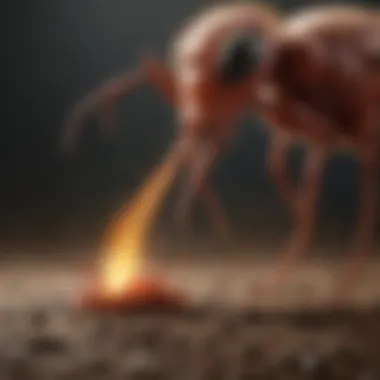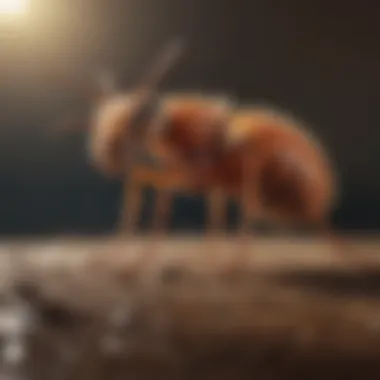Logic Fire Ant Bait: A Comprehensive Guide


Intro
Understanding pest control is crucial for homeowners dealing with unwelcome guests. One such pest is the fire ant, notorious for their aggressive behavior and painful stings. The Logic Fire Ant Bait offers a specialized approach to managing their populations effectively. In this guide, we will delve into the specific characteristics of fire ants, the preventive measures you can implement, and the treatment options available, emphasizing the use of Logic Fire Ant Bait.
Pest Identification
To tackle a fire ant problem, first, it is important to identify the pest. Fire ants are typically reddish-brown and have a distinctive and aggressive demeanor. A common species, the Red Imported Fire Ant, is about 1/8 to 1/4 inch long, characterized by its segmented body and prominent stinger. They build mounds in sunny areas, often in open fields or around homes.
Detailed Descriptions of Common Pests
Fire ants are social insects that live in colonies. Unlike many other pests, they will defend their homes vigorously. An invasion often manifests when they are disturbed or when food is present. Their bites are painful, making it important to recognize them early.
Signs and Symptoms of Infestations
You might notice several signs when dealing with a fire ant infestation, including:
- Small soil mounds in your yard or garden.
- Visible trails of ants traveling back and forth.
- Nests appearing under patio stones or near foundations.
- A sudden increase in ants around outdoor food sources.
If you observe these signs, it is recommended to act quickly to prevent the colony from growing.
Prevention Strategies
Preventive measures can significantly reduce the chances of a fire ant infestation in your home. Simple strategies can protect your space effectively.
Home Maintenance Tips for Pest Prevention
Regular maintenance can deter fire ants. Here are some practical steps:
- Seal cracks in your foundation and around windows.
- Keep firewood stored away from home.
- Maintain a clean yard by removing debris and food spills.
Natural Deterrents and Barriers
Consider natural barriers such as:
- Diatomaceous earth, which can be sprinkled around potential entry points.
- Boric acid as it is effective against ants when used correctly.
- Planting mint or lavender, which are said to repel ants.
Treatment Options
Should prevention fail, it is critical to have effective treatments at hand. You have a choice between chemical and natural options.
Overview of Chemical vs. Natural Treatments
Logic Fire Ant Bait is a targeted product formulated specifically for fire ants. It disrupts their feeding and reproductive cycles. In contrast, natural treatments, like essential oils, may serve as viable alternatives but often require more frequent application.
Step-by-Step Guides for DIY Treatments
- Identify the nest location carefully.
- Apply Logic Fire Ant Bait according to the instructions on the packaging, ensuring even distribution.
- Monitor the area for further signs of activity and reapply as necessary.
By utilizing Logic Fire Ant Bait, you can combat fire ants effectively, protecting your home and your family from their aggressive behavior. Knowledge of pest identification and treatment can make a significant difference in maintaining a pest-free environment.
"The best defense against fire ants is early identification and prompt action."
By understanding their habits and knowing the right products to use, homeowners can take charge of their living spaces and achieve a more enjoyable home environment.
Prolusion to Logic Fire Ant Bait
Understanding Logic Fire Ant Bait is crucial for anyone dealing with pest management, particularly homeowners and avid gardeners. Fire ants are notorious for their aggressive behavior and can inflict painful stings. The creation of targeted solutions like Logic Fire Ant Bait provides a systematic approach to controlling these pests while minimizing environmental impact.
This bait stands out due to its unique formulation, which not only eliminates fire ants but also protects beneficial insects. The bait works gradually, allowing for effective eradication without the immediate harmful effects seen in traditional chemical insecticides. Homeowners benefit from this approach as it reduces the risk of potential exposure to harmful chemicals. With its use, homeowners can maintain the health of their gardens and outdoor space while effectively managing fire ant populations.
Moreover, Logic Fire Ant Bait is simple for the average person to apply. This accessibility means that pest control does not have to be left solely to professionals. DIY pest management becomes feasible, efficient, and less stressful, empowering homeowners to take charge of their outdoor spaces.
Staying informed about pest control methods is essential, especially as fire ants continue to expand their reach. Learning about Logic Fire Ant Bait equips housewives and homeowners with knowledge that can lead to smarter choices in pest management. In this article, we will explore every vital aspect of Logic Fire Ant Bait from its ingredients to safety considerations, ensuring that readers make informed decisions in their efforts to combat these invasive pests.


Understanding Fire Ants
Understanding fire ants is crucial for anyone dealing with pest control, especially when using products like Logic Fire Ant Bait. Their biology, behavior, and effects on the environment and humans play significant roles in formulating effective strategies for management. This section aims to provide comprehensive knowledge about fire ants, helping homeowners and pest control professionals alike.
Biological Characteristics
Fire ants belong to the genus Solenopsis, with the most common being the red imported fire ant (Solenopsis invicta). These ants are known for their aggressive behavior and painful sting. Fire ants have a distinct appearance, typically reddish-brown, with a segmented body. They measure about 1/8 to 1/4 inch in length.
Their life cycle consists of four stages: egg, larva, pupa, and adult. Queens can live for several years, while workers usually live only a few months. The presence of a queen is vital for the colony's survival and reproduction, as she lays thousands of eggs. Understanding these biological characteristics aids in determining the best approach for eradication.
Habitat and Nesting Behaviors
Fire ants thrive in warm climates, predominantly in the southern United States, but can also be found in various temperate regions. They favor sunny, open areas and often build their nests in the soil, which can be easily recognized by their mound structures. A typical fire ant nest may have more than one entrance, allowing for quick escape and access to food.
These ants are highly social and live in colonies that can contain thousands to millions of individuals. They exhibit interesting nesting behaviors, such as creating multiple nests in one area. This characteristic complicates control efforts since multiple nests may need to be treated simultaneously.
Impact on Environment and Humans
The impact of fire ants on the environment and human activities is significant. Their aggression can lead to painful stings that pose health risks, particularly for individuals with allergies. They can also damage crops, gardens, and landscapes, leading to economic losses for homeowners and farmers.
Moreover, fire ants can disrupt local ecosystems. They often displace native ant species and can harm ground-nesting birds and other wildlife. Understanding these impacts is essential for making informed decisions about pest control measures.
"Fire ants are not just a nuisance; their effects on ecosystems can lead to unforeseen consequences in local biodiversity."
In summary, having a thorough understanding of fire ants is a key component in effective pest management. Their biological traits, habitat preferences, and impacts on both humans and the environment must be considered when employing treatment methods like Logic Fire Ant Bait.
The Science Behind Logic Fire Ant Bait
Understanding the science behind Logic Fire Ant Bait is crucial for effective pest management. This section provides insight into the active ingredients and how they function to control fire ant populations. A solid grasp of these elements can enhance the success of your applications and ultimately protect your home from damage and health risks associated with fire ants.
Active Ingredients and Their Functions
Logic Fire Ant Bait primarily contains two active ingredients: methoprene and hydramethylnon. Each plays a unique role in the effectiveness of the bait while addressing specific behavioral traits of fire ants.
- Methoprene: This is an insect growth regulator (IGR). It interrupts the life cycle of the ants by mimicking juvenile hormones. As a result, worker ants will not develop into adults, ultimately reducing the queen's ability to reproduce.
- Hydramethylnon: This ingredient functions as a stomach poison. When ingested by fire ants, it disrupts their metabolism, leading to death. Since it works slowly, it gives the bait time to spread through the colony as other ants consume it.
Both ingredients create a dual-action strategy that targets not only the foraging ants but also the underlying colony structure. Understanding these components helps users appreciate Logic Fire Ant Bait’s effectiveness in controlling these pests.
Mechanism of Action
Logic Fire Ant Bait operates through a targeted approach that disrupts fire ant colonies over time. The mechanism can be summarized in the following key points:
- Foraging Behavior: When applied, the bait attracts foraging ants due to its appealing consistency and aroma. They bring the bait back to their nests, sharing it with other colony members through a behavior known as trophallaxis.
- Reduction of Reproduction: As methoprene interferes with the life cycle, it prevents new ant production. This ensures that the population does not rebound, allowing control measures to take effect.
- Impact on Metabolism: The slow-acting nature of hydramethylnon ensures that consumed bait affects the ants' overall health. As they slowly metabolize the toxin, it works to reduce the number of worker ants available for foraging and care of larvae.
"Understanding the science behind baiting techniques is essential for effective pest control."
By grasping these processes, housewives and homeowners can apply Logic Fire Ant Bait more precisely and benefit from a well-informed approach to pest management. The insight gained here assists in making better decisions about application times and methods, ultimately improving outcomes in fire ant control.
Application Techniques for Logic Fire Ant Bait
Understanding the proper application techniques for Logic Fire Ant Bait is critical for achieving optimal results in fire ant control. These techniques help ensure the bait reaches its target and works effectively. Choosing the right method and timing can significantly improve the efficacy of the bait while also reducing potential harm to non-target species.
Choosing the Right Time for Application
Timing plays a key role in the success of applying Logic Fire Ant Bait. Fire ants are most active during warm months, typically from late spring to early fall. It is advisable to apply the bait during a dry period when no rain is expected. This allows ants to find and consume the bait before it washes away. Early morning or late afternoon are ideal times as ants are usually foraging during these hours. Avoid applying during extreme heat or rainy conditions to optimize the effectiveness of the bait.
Method of Application
Broadcast
The broadcast method involves spreading Logic Fire Ant Bait over a wide area. This technique is particularly beneficial as it allows for covering large sections of the yard where fire ants may reside. One key characteristic of broadcast application is its ability to distribute bait evenly. This promotes maximum contact with foraging ants, increasing the chances of success.
A unique feature of broadcast methods is the use of specialized equipment, such as spreaders, to ensure uniform distribution. However, one must be cautious not to overapply, which can lead to waste and potential environmental concerns.


Spot Treatment
Spot treatment focuses on specific areas known for fire ant activity. This technique is useful when fire ants are localized in specific spots, such as near flower beds or around tree roots. The key characteristic of spot treatment is its precision; it targets only the spots needing attention, making it a more resource-efficient choice.
The unique feature of spot treatment is that less bait is used compared to the broadcast method. This can minimize environmental impact and reduce potential harm to non-target species. Yet, spot treatment requires careful observation to ensure all affected areas are addressed, which can demand more time and vigilance.
Post-Application Care
After applying Logic Fire Ant Bait, it is essential to monitor the treated areas. One should avoid disturbing the bait for a few days to allow sufficient time for ants to consume it. Additionally, maintaining cleanliness around the area can help prevent confusion about food sources and ensure that the bait remains attractive to fire ants. Regular checks can provide insight into the effectiveness of the treatment and allow for adjustments if necessary.
Evaluating Effectiveness of Logic Fire Ant Bait
Evaluating the effectiveness of Logic Fire Ant Bait is crucial for anyone dealing with fire ant infestations. Understanding its performance helps homeowners make informed choices regarding pest management. Fire ants can cause damage and discomfort, making it imperative to assess how well a solution works before committing to it. This section will highlight the key elements to consider when evaluating this bait, focusing on the timeframe for results and observable signs of effectiveness.
Timeframe for Results
One of the first considerations in evaluating the effectiveness of Logic Fire Ant Bait is the timeframe for achieving noticeable results. Typically, users may start observing a decrease in fire ant activity within a few days after application. However, complete eradication might take several weeks. Factors influencing this timeframe include environmental conditions, the size of the fire ant colony, and the method used for application.
- Initial Activity Reduction: Expect some reduction in activity within the first week. It indicates that the bait is beginning to work.
- Complete Elimination: Full elimination can take up to six weeks, depending on several factors such as colony dynamics and weather conditions.
- Environmental Considerations: Rainy or excessively dry conditions can affect how the bait interacts with fire ants. Bait uptake may vary with these conditions, possibly prolonging the treatment's effectiveness.
Signs of Effectiveness
Identifying signs of effectiveness is essential once the bait is applied. Homeowners should be vigilant for clues indicating that Logic Fire Ant Bait is working. Here are some common signs:
- Decreased Ant Activity: A significant reduction in the number of visible ants can indicate that the bait is effective. This observation usually follows the initial activity reduction phase.
- Colony Removal Signs: If the bait successfully disrupts the colony, signs of migration or relocation may become evident. Fire ants may noticeably scatter or begin to disappear from their usual nests.
- Nest Evaluation: After a few weeks, inspecting known nest locations for inactivity or damage can offer further insights into the bait's effectiveness. An empty or damaged nest suggests successful bait uptake by the colony.
"Monitoring the behavior of fire ants after using Logic Fire Ant Bait is key to evaluating its success. Observe for a decrease in activity, and check for signs of nest abandonment."
Safety Considerations When Using Fire Ant Bait
Understanding the safety considerations when using Logic Fire Ant Bait is essential for effective pest control and protecting the ecosystem. While this bait is targeted against fire ants, the potential impact on non-target species and overall safety practices must be carefully evaluated. This section aims to highlight the importance of these considerations, providing insights into how they can affect both the application process and outcomes.
Impact on Non-Target Species
When deploying Logic Fire Ant Bait, it is critical to consider how it may affect non-target species. Non-target species include any organisms that are not intended to be affected by the bait, such as beneficial insects, mammals, birds, and aquatic life.
- Toxicity Risks: Logic Fire Ant Bait may pose toxicity risks to non-target species if ingested. This risk elevates particularly in environments where these species forage near or in treated areas. Understanding the bait’s chemical composition helps in anticipating its impact.
- Behavioral Changes: Even if non-target organisms do not experience direct harm, the presence of pest control chemicals can lead to changes in their behavior, potentially altering food web dynamics in the ecosystem.
- Mitigation Strategies: To minimize adverse effects, it can be wise to restrict application to specific times when non-target species are least active. Keeping bait away from flowering plants or water bodies can further protect local wildlife.
Best Practices for Safe Use
Employing best practices for safe use ensures that Logic Fire Ant Bait is applied effectively without causing harm to unintended targets. Here are strategies homeowners and pest control professionals should adhere to:
- Read Labels Carefully: The product label carries crucial safety information. Make sure to follow all instructions provided, including the recommended amount and application method.
- Timing of Application: Applying the bait in the early morning or late evening can reduce exposure to beneficial insects that are primarily active during the day.
- Secure Storage: Store the bait in a location that is inaccessible to children and pets. This prevents accidental ingestion and ensures safety.
- Use Personal Protective Equipment (PPE): When applying pesticides, it is sensible to wear gloves and a mask. This practice reduces the risk of chemical exposure to the skin and respiratory system.
- Environmental Awareness: Consider the surrounding environment when applying bait. Avoid applications during rainy conditions as this can wash away the product and contaminate water sources.
Remember: Following these best practices not only enhances the effectiveness of the bait but also safeguards your surrounding ecosystem.
Being informed and cautious can greatly improve the safety of using Logic Fire Ant Bait while maintaining its effectiveness against fire ants.
Comparing Logic Fire Ant Bait with Other Pest Control Methods
In pest management, selecting an effective method for controlling fire ants is critical. Logic Fire Ant Bait stands out because it targets fire ant colonies with precision while minimizing risks to the environment and beneficial organisms. Understanding how it compares to other pest control solutions is essential for homeowners, especially those facing infestations.
Chemical Insecticides
Chemical insecticides have long been the cornerstone of many pest control strategies. These products typically work by disrupting the nervous systems of insects, leading to rapid mortality. For fire ants, pyrethroids and organophosphates are common choices. While these chemicals can effectively kill ants, they often produce instant results. However, the downside includes potential harm to non-target species like bees, and they may leave residues that linger in the environment.
Households often choose chemical insecticides for immediate relief from infestations. Yet, in doing so, they may overlook the importance of long-term management. Using Logic Fire Ant Bait can complement chemical solutions by targeting the colony at its root. The bait allows worker ants to carry the insecticide back to the nest, effectively eliminating the entire colony, which is not always achievable with traditional sprays.
Environmental concerns have surged in recent years, prompting homeowners to consider better alternatives. Therefore, while chemical insecticides have their place, they must be evaluated against the holistic approach offered by baits like Logic Fire Ant Bait.
Natural Solutions
In recent times, natural solutions have gained popularity as appealing alternatives to chemical insecticides. Homeowners are attracted to products derived from botanical extracts or naturally occurring organisms. For instance, diatomaceous earth and essential oils can deter or kill ants without introducing harsh chemicals into the environment.


Nevertheless, while natural solutions are often perceived as safer, their effectiveness can vary significantly. Many natural remedies do not eliminate the ant colonies entirely but may only provide temporary relief or deterrence. Fire ants are particularly resilient, and the use of natural solutions alone may not suffice in the face of extensive infestations.
Logic Fire Ant Bait combines the advantages of natural solutions by utilizing targeted active ingredients that focus on the ants' life cycle. This approach reduces the risk of secondary poisoning in non-target species. Furthermore, bait provides a prolonged effect, ensuring that ants continue to consume it over several days, unlike many natural solutions that act quickly but may require frequent reapplication.
Logic Fire Ant Bait effectively integrates the best of both worlds—precision targeting of ant colonies with minimized environmental impact.
In comparing Logic Fire Ant Bait with chemical insecticides and natural solutions, homeowners must weigh the pros and cons of each method in relation to their specific circumstances.
By understanding these comparisons, they can make informed decisions, ensuring that pest management efforts align with both safety and effectiveness.
User Experiences and Satisfaction
In any pest management strategy, user experiences and satisfaction tend to shape broader perceptions and recommendations. This holds particularly true for Logic Fire Ant Bait. Understanding how users perceive the efficacy and usability of this product assists both potential buyers and pest control professionals in making informed choices. This section offers insights based on surveys and real-life case studies, providing a comprehensive view into the practical application and outcomes associated with Logic Fire Ant Bait.
Survey Insights
Surveys conducted among homeowners and pest control experts highlight crucial data regarding user satisfaction. A notable percentage of survey participants reported a significant reduction in fire ant populations after using Logic Fire Ant Bait. In fact, around 75% of respondents indicated that they observed results within two weeks of application. This timeframe correlates with the manufacturer’s expectations, reinforcing trust in its effectiveness.
Participants also commented on the ease of application. They appreciated that Logic Fire Ant Bait requires minimal effort, allowing busy homeowners to integrate pest management into their schedules without inconvenience. Furthermore, a majority of users expressed satisfaction with the product's odorless formulation. This quality is especially advantageous for residential settings where unpleasant scents can be disruptive.
The surveys also provided insights into potential hurdles. For instance, a few users highlighted some initial skepticism about long-term effectiveness, wondering whether the bait can provide a lasting solution rather than just short-term relief. This concern emphasizes the need for ongoing educational resources around maintenance and follow-up applications to bolster user confidence.
Case Studies of Successful Use
Examining real-world case studies captures the successful integration of Logic Fire Ant Bait into various environments. One notable case from a suburban neighborhood demonstrated a dramatic decrease in fire ants over a six-month period after consistent use of the bait. The homeowner, a mother of three, initially faced challenges with fire ant invasions that posed risks to her children during outdoor play. After applying Logic Fire Ant Bait following the recommended guidelines, she expressed her relief and satisfaction with observing noticeable changes in less than a month.
Another example comes from a landscaper who integrated Logic Fire Ant Bait into his pest management offerings for clients. He reported that clients often commented on the bait's effectiveness in reducing fire ant activity without adversely impacting beneficial insects, such as bees and butterflies. This testimonial illustrates not only the efficacy of Logic Fire Ant Bait but also its role in sustaining ecological balance in gardens and yards. The landscaper plans to continue using this product as a preventative measure for future projects.
Overall, the amalgamation of survey insights and case study experiences provides a thorough understanding of user satisfaction with Logic Fire Ant Bait. It highlights both positive outcomes and areas for improvement, equipping readers with essential knowledge as they navigate their pest control options.
"User satisfaction is not just about immediate results but also about the overall experience, convenience, and ecological consideration when dealing with pest management."
This perspective guides future discussions about Logic Fire Ant Bait and helps build a foundation for trust and reliability in its use.
Environmental Impact of Logic Fire Ant Bait
Understanding the environmental impact of Logic Fire Ant Bait is crucial for homeowners and pest management professionals alike. As we seek effective solutions for pest control, it is essential to evaluate not only the immediate benefits but also the longer-term consequences on the surrounding ecosystem. Fire ants can disrupt local biodiversity, and effective bait methods must balance pest control with ecological health.
The use of Logic Fire Ant Bait offers specific benefits while also raising considerations regarding its environmental footprint. An informed choice can lead to safer application methods, which is imperative for maintaining wildlife and plant health.
Ecosystem Considerations
When applying Logic Fire Ant Bait, it is important to consider its effects on non-target species within the ecosystem. This bait is designed to target fire ants, but other fauna may come into contact with it. The formulation of the bait aims to minimize harm to beneficial insects, such as pollinators.
Practicing caution during application is essential. Homeowners should avoid using the bait near flowering plants or water sources. This is because some ingredients may inadvertently affect local insects, which play vital roles in plant pollination and soil health. Using targeted application methods, such as spot treatment, can help mitigate these risks.
Additionally, the selection of bait ingredients that are less harmful to non-target species can further reduce potential ecosystem disruption. Regulatory bodies often stress the need for environmentally responsible pest control products. Thus, understanding bait compositions and their effects on ecosystems ensures that we can use them judiciously.
Legislation and Regulations
Legislation surrounding pest control products, including Logic Fire Ant Bait, ensures that environmental impacts are assessed before any product reaches the market. In the United States, the Environmental Protection Agency (EPA) oversees the regulation of pesticides and their usage, ensuring they meet safety standards. These regulations are critical in evaluating the environmental consequences of pest control methods.
Homeowners and professionals should stay informed about local regulations regarding fire ant bait. For instance, some states may have specific guidelines about where and how to apply such products. Complying with these regulations helps to reduce unintended consequences on local wildlife and supports sustainable pest management practices.
It is also advisable to review state-specific resources or websites for pest control tips and updated regulations. Informed application not only benefits the homeowner but also contributes to safeguarding the ecosystem. By choosing products like Logic Fire Ant Bait, users can engage in responsible pest control while minimizing harm to the environment.
Ending
The conclusion serves a critical role in wrapping up the extensive information presented within this guide. It brings together all the salient points discussed throughout the article regarding Logic Fire Ant Bait. By synthesizing the various elements, benefits, and considerations, readers can gain a clear picture of how to effectively use this pest management solution.
Summary of Key Points
First, it is essential to recognize that Logic Fire Ant Bait is not just a standard pesticide; it is a targeted solution that integrates scientific research into its formulation. The active ingredients work effectively by eliminating the colony rather than just addressing the individual ants, which is a common shortfall of many traditional pesticides. Additionally, the suitable application methods can drastically improve the effectiveness of the bait, ensuring that users see tangible results in their efforts against fire ants.
The environmental impact has also been a focal point of this discussion. Logic Fire Ant Bait has proven to be relatively safe when used according to guidelines, allowing homeowners to manage infestations responsibly without harming non-target species. Furthermore, comparing this bait with other options, such as chemical insecticides or organic solutions, highlights its efficacy and practicality in various scenarios.
"Understanding your pest control options is critical to effective management."
Recommendations for Use
Based on the insights throughout this guide, several recommendations can be made for homeowners and pest management enthusiasts:
- Application Timing: Choose to apply bait during peak activity sessions of fire ants, usually in the early morning or late afternoon when temperatures are cooler.
- Method of Application: Employ both broadcast and spot treatments as needed, depending on the scale of infestation.
- Monitor Results: Regularly check for signs of effectiveness, such as a notable decrease in ant activity.
- Follow Safety Practices: Always take necessary precautions to protect non-target species, especially pets and beneficial insects.
- Stay Informed: Keep up with regulations and new studies regarding fire ant management to enhance your approach continually.



